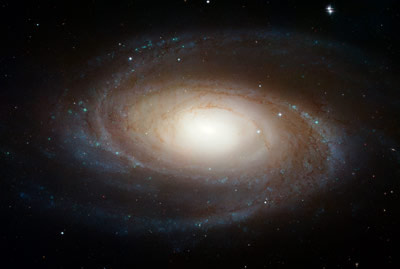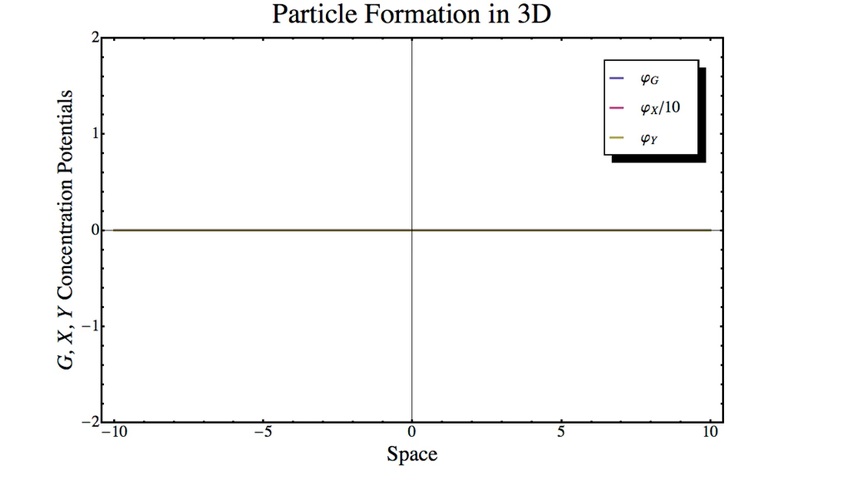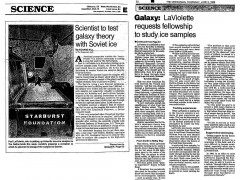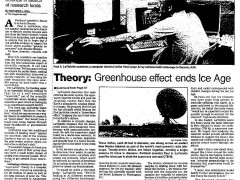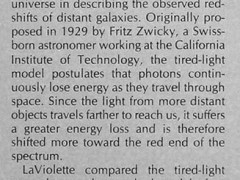Author Archives: luxus
Computer Simulation of Model G
Below is a simulation of the formation of a 1D particle in Model G using the Crank-Nicolson method. This is based on the research paper Stationary Dissipative Solitons of Model G.
The 10 parameters on the left correspond to eqs. (17). To begin the simulation, press "Run" and wait several seconds. Contact.
Please select here for full screen run.
SQK Cosmology
(courtesy of NASA, ESA, and the Hubble Heritage Team)
Subquantum Kinetics leads to a stationary universe cosmology, in which the cosmological redshift is predicted to arise from a “tired-light” effect
Evidence Against the Expanding Universe Hypothesis
Edwin Hubble did not favor the expanding universe hypothesis
Modern cosmologists and astronomy historians are misguided in attributing the expanding universe hypothesis to the twentieth century astronomer Edwin Hubble. For, in his writings Hubble consistently doubted the Doppler shift interpretation, always referring to the galaxy redshifts as "apparent velocities." Hubble, in fact, favored the tired-light interpretation, the proposal that photons lose energy as they travel through interstellar space, finding that it offered a more reasonable interpretation of the observational data. However, he realized that to adopt this interpretation would require admitting that it was due to "some hitherto unrecognized principle in physics." Indeed, one interpretation of the tired-light theory, which suggests that the lost energy disappears entirely from the physical universe, directly conflicts with the strict interpretation of the First Law of Thermodynamics. Although the law of energy conservation has been verified at the macroscopic level, e.g., in the operation of refrigerators and such, it has not been proven to apply to very small effects such as might explain the cosmological redshift (energy losses of the order of 10-18 per second). Nevertheless there are many physicists and astrophysicists whose feathers would be ruffled at the idea that the Law might not hold true even at such miniscule levels.
Vincent Sauvé presents an excellent historical review of Hubble's writings and his stance against wholesale acceptance of the expanding universe hypothesis. He also challenges some big bang assertions.
Also, in chapter 13 of his book Genesis of the Cosmos, Paul LaViolette presents an historical overview of the discovery of the galaxy redshifts during the early 20th century and how astronomers misled themselves to follow the Doppler shift interpretation which led to the conclusion of an expanding universe.
Frontier Physics: Subquantum Kinetics
The time will inevitably come when mechanistic and atomic thinking will be put out of the minds of all people of wisdom, and instead dynamics and chemistry will come to be seen in all phenomena. When that happens, the divinity of living Nature will unfold before our eyes all the more clearly.
Johann von Goethe, 1812
.
The time spoken of has now come.
Discover Subquantum Kinetics!
Starburst conducts research on subquantum kinetics, a new microphysics methodology that has successfully solved many of the problems that presently confront physics and astronomy. Its approach was inspired from general system theory and from concepts that were originally developed to explain the formation of chemical wave patterns in certain nonlinear chemical reaction systems. Subquantum kinetics applies these wave-order generating concepts to give an entirely new approach to understanding physical phenomena. It expands the scope of physics with the awareness that our material universe of subatomic particles, fields, and energy waves is a part of a larger higher dimensional whole that remains inaccessible to direct sensory perception.
Subquantum kinetics is simple and elegant. Using a set of five nonlinear equations having three variables, it presents a rigorous unitary description of the physical world accounting for all force fields and relativistic effects in a unified manner. Its systems approach brings a new common sense understanding of physical concepts and heals the schism that has traditionally separated physics from the life sciences. It changes the limits of what was once thought to be possible and opens up new possibilities for the development of technologies in energy generation and aerospace propulsion that could better our world. Details about this new physics are presented in Dr. LaViolette's books Subquantum Kinetics (technical) and Genesis of the Cosmos (general readership).
.
fluctuation forming a neutrally charged subatomic particle. The amplitude of the
X and Y variables corresponds to electric potential and the amplitude of the G
variable corresponds to gravity potential.
.
.
.
.
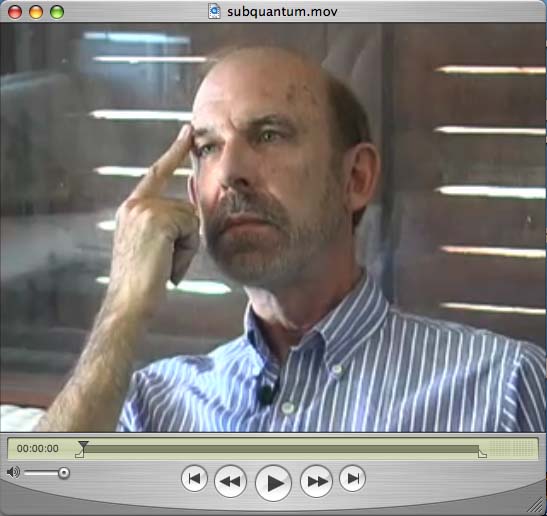
Click above to view interview
.
Subquantum Kinetics (nontechnical summary)
Subquantum Kinetics
(a nontechnical summary)
Subquantum kinetics is a novel microphysics paradigm that incorporates concepts developed in the fields of system theory and nonequilibrium thermodynamics. One of its distinctive features is that it begins at the subquantum level for its point of departure. By comparison, conventional physics and most alternative physics theories begin with mathematically quantified observations of physical phenomena at the quantum and macrophysical level and attempt to deduce physical theories based on those observations. Since the conventional approach must take into account numerous experimental observations, the end result is a fragmented and often contradictory set of theories which must later be sewn together with mathematical acrobatics. Such "unified field theories" more closely resemble a patchwork quilt than a contiguous fabric.
Instead of beginning with physical observations, subquantum kinetics begins by postulating a set of well-ordered reaction processes that are proposed to take place at the subquantum level. Collectively, these reaction processes compose what is termed the transmuting ether, an active substrate that is quite different from the passive mechanical ethers considered in the eighteenth and nineteenth centuries. It further proposes that the concentrations of the substrates composing this ether are the energy potential fields that form the basis of all matter and energy in our universe. The operation of these ether reactions causes wave-like field gradients (spatial concentration patterns) to emerge and form the observable quantum level structures and physical phenomena (e.g., subatomic particles with mass, charge, spin, and force field effects and electromagnetic waves).
So, subquantum kinetics: a) begins with a mathematical model of subquantum processes; b) it then computer simulates this model to generate quantum level phenomena; and c) it compares the model's simulated results to actual observations. The model's mathematical parameters are then "fine-tuned" so that its simulated results accurately reflect experimental observation, thereby making the model a realistic representation of the physical world. Because, it begins with a single reaction system model as its point of departure for describing essentially all observable physical phenomena, subquantum kinetics qualifies as a unified theory. By comparison, conventional physics begins with many theories conceived independently from one another and later attempts to "sew" these together. But the result is far from unified, being instead a self-contradictory aglomeration.
In choosing an adequate model to represent subquantum process, subquantum kinetics turns to the macroscopic natural world, to theories describing how certain reaction systems spontaneously evolve well-ordered wave patterns. This self-organization phenomenon, for example, is seen in the Belousov-Zhabotinskii reaction, a chemical reaction first discovered in 1958. Slowly moving concentration fronts called chemical waves, or "reaction-diffusion waves," can be discerned when a dye indicator is added to this reacting solution.
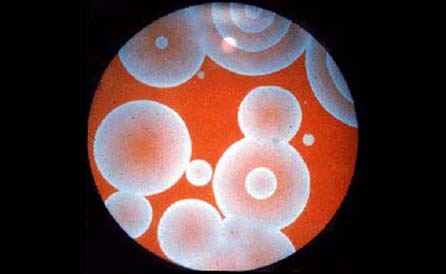
The Belousov-Zhabotinskii reaction. A dye indicator elucidates wave-like zones of regularly alternating chemical ion concentration that spontaneously arise in the reacting solution. (Photo courtesy of Arthur Winfree)
A video showing the formation of chemical waves, both
spiral and concentric in the Belousov-Zhabotinskii reaction.
Wave patterns and wave motion may also be produced mechanically, as is commonly experienced in the movement of water waves or in the vibrations of a violin string. Early physical theories, in fact, proposed mechanical ether models in an attempt to describe phenomena such as light wave propagation. However, such models lead to very different assumptions about primary creation. a mechanical universe could not arise spontaneously, instead requiring the miraculous injection of an initiating energy impulse inexplicably arising out of a state of non-existence. Such mechanical models are inadequate for the approach outlined here which postulates an orderly and explicable process of creation.
Subquantum kinetics was partly inspired from work done on a reaction kinetic model known as the Brusselator. This two-variable model holds the distinction in the field of reaction-kinetics of being an archetypal reaction-kinetic oscillator comparable in simplicity to the simple harmonic oscillator of wave mechanics. That is, it is the simplest reaction system known to produce wave patterns that have well-defined wavelength properties. To arrive at a model that produces a physically realistic simulation of quantum structures, the Brusselator must be modified into the three-variable reaction system known as Model G. Hence in proposing Model G as a descriptor of the subquantum processes that generate physical order, subquantum kinetics takes concepts that have been developed in the well-established field of nonlinear chemical kinetics and applies them to the domain of microphysics.
The subquantum kinetics paradigm avoids many of the pitfalls of conventional physics and astronomy theories and interprets physical phenomena in a distinctively different manner. A listing of the numerous problems of the conventional paradigm and how subquantum kinetics resolves them is presented in the following tables.
News, Stories and Reviews
News Stories and Reviews
Related to Starburst Research
Superwave Theory
• Oregonian, June 8, 1988 (larger view)
• Oregonian, November 3, 1988 (larger view)
Cosmology
• Astronomy magazine, AstroNews section, August 1986
Subquantum Kinetics
• "LaViolette prediction of Pioneer anomaly challenges energy conservation law," Enews Blog of Sepp Hasslberger
• Book review by Prof. Podkletnov in Infinite Energy magazine
- Oregonian, June 8, 1988 (Click to zoom)
- Oregonian, November 3, 1988 (Click to zoom)
- Astronomy magazine, AstroNews section, August 1986 (click to zoom)
Interviews and News
Video Interviews, News Interviews, and Talkshow Interviews
https://www.youtube.com/watch?v=oURVtGKW420
and subquantum kinetics (August 2009)
Interview download site (File size: 319 MB)
.
.
Paul LaViolette speaking about Galactic superwaves and radio pulsar beacons (January 2006)
Part 1
.
Part 2
.
Part 3
.
Paul LaViolette speaking about subquantum kinetics, galactic superwaves,
and physics establishment repression (January 2005)
T. T. Brown, Project Skyvault technology, the Electrogravitics Systems report
classification of the technologies, closed-minded bias in science, suppression
of new technologies, more on the B-2 and subquantum kinetics
Physical Society lobby , illegal Patent Office activities and need for reform
Other interviews are archived at the Sphinx Stargate website
The cosmic ray electron volley of Crab Nebula
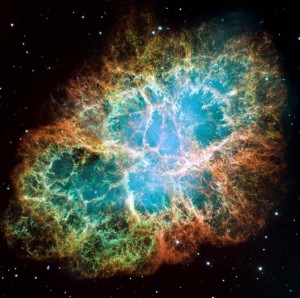 In his 1983 Ph.D. dissertation, Paul LaViolette presented the novel theory that most of the radiation coming from the Crab Nebula is not due to cosmic ray emission coming from the Crab pulsar, but rather is produced by a cosmic ray electron volley (a galactic superwave) that is currently propagating toward the galactic anticenter and impacting the remnant face on. He theorized that these superwave cosmic rays are currently being captured by the magnetized plasma forming the Crab remnant which causes them to emit synchrotron radiation, thus illuminating the nebula.
In his 1983 Ph.D. dissertation, Paul LaViolette presented the novel theory that most of the radiation coming from the Crab Nebula is not due to cosmic ray emission coming from the Crab pulsar, but rather is produced by a cosmic ray electron volley (a galactic superwave) that is currently propagating toward the galactic anticenter and impacting the remnant face on. He theorized that these superwave cosmic rays are currently being captured by the magnetized plasma forming the Crab remnant which causes them to emit synchrotron radiation, thus illuminating the nebula.
Recent observations of the occurrence of gamma ray flares in the Crab nebula help support LaViolette’s theory.
(For more information visit our Superwave Forum).
Paul LaViolette's Seminar at Amsterdam (3-27-2011)
Paul LaViolette's Seminar at Amsterdam
(March 27th 2011)
Paul LaViolette will give one-day seminar in Amsterdam on March 27th, which will cover a broad range of subjects: Subquantum Kinetics, Ether Physics, Continuous Creation Cosmology, Free Energy and Gravity Control Technologies, Advanced science encoded in ancient creation myths, and much more.
All revenues remaining after covering speaker costs will be donated by HealingSoundMovement to WorldPeaceChild, an organisation helping out children all over the world through art, music, dance, intention and real connection.
For more information go to healingsoundmovement.com

